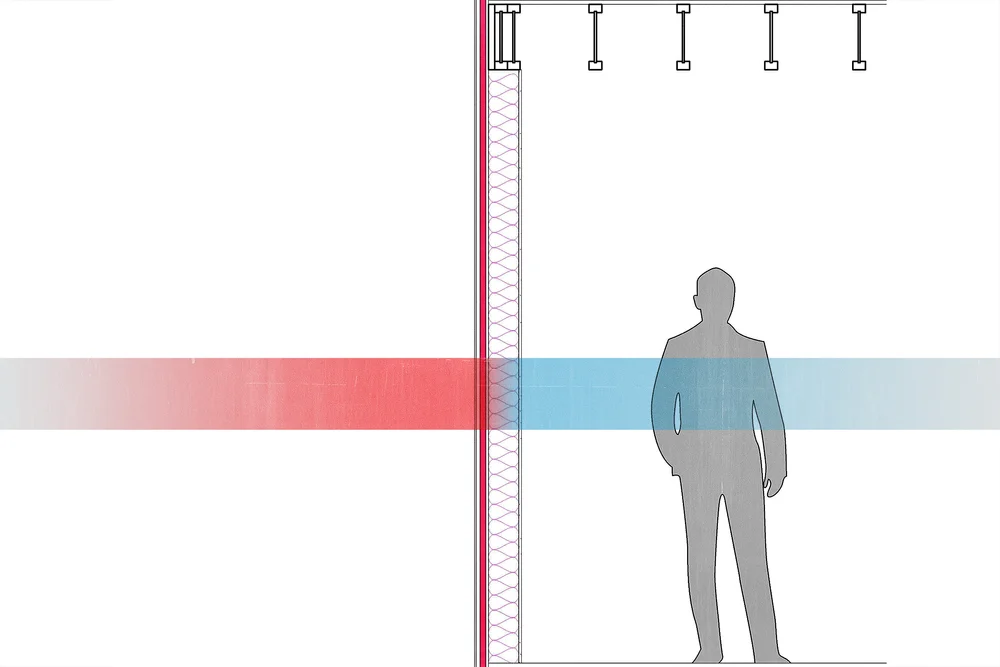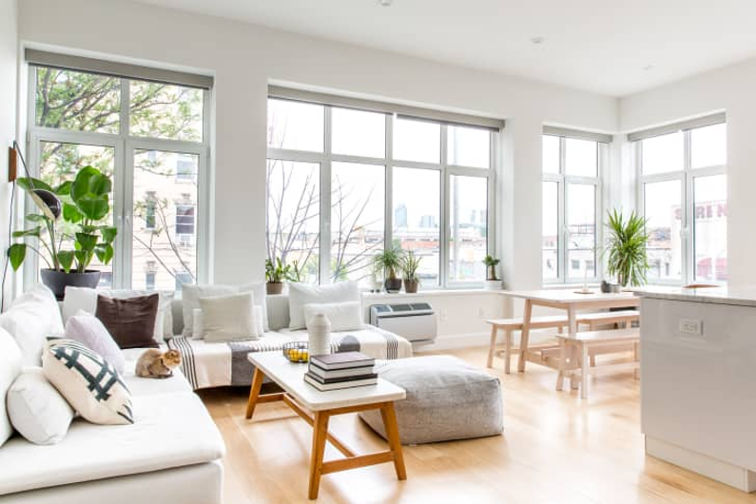Residential Wall Design Part 2: Wall Functional Considerations:As we mentioned in the previous blog on Wall Aesthetics, in addition to looking good, the walls of your house need to perform three very important functions; structural, thermal protection and moisture...
Residential Wall Design Part 2: Wall Functional Considerations:
As we mentioned in the previous blog on Wall Aesthetics, in addition to looking good, the walls of your house need to perform three very important functions; structural, thermal protection and moisture protection. We will focus on the second two, as they are both at the core of how modern residential building science is improving home construction.

Framed walls ready for insulation.
Background:
The American Society of Heating and Air Conditioning Engineers (ASHAE) was founded in 1894, and the American Society of Refrigerating Engineers (ASRE) was ten years behind in 1904. In 1959 these two merged to form the American Society of Heating, Refrigerating and Air-Conditioning Engineers (ASHRAE) Obviously the Department of Non-confusing Acronyms (DNA) has yet to be formed in Washington.
Prior to the 1973 energy crisis, the topic of building passive houses was far from the mainstream. The ideas were nurtured by those with primarily scientific concerns, producing often unusual building designs that responded to severe desert or very cold environments. The Energy Reorganization Act of 1974 created the Energy Research and Development Administration (ERDA) and by 1977 this was consolidated with several other government energy related organizations under the Department of Energy Organization Act. DOE was born.
Now with the engineers aligned, the regulatory agencies formed and empowered to codify, and the newfound sense of urgency surrounding energy efficiency the movement gained mainstream momentum.
By 2000 the International Code Council created the IECC (International Energy Conservation Code) which has been updated every 3 years since. As of this writing most main stream jurisdictions have adopted either the 2012 or 2015 version, and many will shortly adopt the 2018 version.
The IECC begins with a Climate Zone map that breaks the United States into 8 climate zones. Based on the zone that your house is in you will have differing requirements with regard to the building envelope.�
The Three Little Pigs Emphasis on Structure

Exterior wall in process of adding siding. The green panels are ZIP sheathing with integrated water barrier.
If the three little pigs were to be re-written in the 21st century, the pigs would be forced to address their structural issues by a rigorous building code that would enforce all types of shear design regulations to guard against ominous earthquakes and gale wind forces. Rather than a wolf being the villain in this story, the pigs would be living in fear of mold spores and a senseless waste of resources expended to keep our little friends both in comfortable air conditioning.
In the 21st century the two primary concerns in wall design are temperature and moisture. Whereas the pigs� safety resided in a strong brick box, they would now be looking at the problem of building a sturdy, and beautiful, thermos.
Goldilocks and Indeterminacy
If Goldilocks had a brother and sister with her the chances are good that as she expressed her satisfaction with the third bowl of porridge being just right, her brother would chime in, �are you kidding me? That baby bear bowl is not hot enough and it is too dry.� Her sister might say, �you�re both nuts, mamma bear had it right, though it is a bit too moist.�
One of the slightly frustrating aspects of thermal design has to do with how indeterminate it is. The initial problem is simple enough, design an efficient building envelope (thermos) and then appropriately size a heating and air conditioning system to keep the interior temperature and humidity relatively stable.
This can get complicated very quickly by both the wide range of exterior conditions and by the variability of how many occupants are using a building and how much heat and humidity they are producing as they use the building.
Finally add to this the varying perceived levels of comfort by the occupants. That�s probably why the three bears left the house in the first place.
The Metrics
To design a better wall, you need to know the criteria on which you will be judged. This can get very granular, so we will keep it to the basics with regard to temperature, moisture, and air tightness.
Temperature:
R VALUE: The ability of an insulating material to resist heat flow. The higher the R value, the higher the insulation power. Technically it is the rate of heat transfer through a material. A typical wall might be insulated to R-21.
U FACTOR: The U Factor is the inverse of the R-Value. It has traditionally been used to measure the flow of heat through windows in housing design. The lower the U, the better the insulative ability.

Moisture:
DEW POINT: Temperature (varying according to pressure and humidity) below which water droplets begin to condense and dew can form. There are several values that effect at what temperature this will occur. With regard to wall design this is very important in that the dew point temperature will occur inside of your wall, so you want to make sure that even in extreme cases (coldest and warmest days of the year) that this will not allow water to form and get trapped in your wall cavity. This will result in mold growth.
PERM RATING:�The rating used to measure how vapor impermeable a vapor barrier or vapor retarder is. Typically, a vapor barrier will have a perm rating of 0.1 or less and can also be called a Class I Impermeable Vapor Retarder. A Class II semi-permeable vapor retarder would have a perm rating of between 0.1 and 1.0. A class III permeable vapor retarder would have a perm rating of between 1 and 10. This will measure how much moisture will be able to penetrate your wall system.
AIR TIGHTNESS:
ACH (Air changes per hour): Number of times in an hour that the volume of air in the house is changed. Basically, any house will leak air. If you think about it every time you leak air, you need to either heat or cool the new air that replaces the leaked air. It�s a little bit like blowing up a balloon that has a few tiny holes in it. If you have enough holes the exercise can become futile. You could have all of the insulation in the world but if you leak away the air the insulation becomes pointless.
PASCAL (SI):�Unit of pressure used to quantify internal pressure or stress. This is the unit by which a Blower Door Test is based. Though it is fairly technical it is worth understanding that the air pressure directly affects how quickly the air will move through small leaks and openings in your wall. SI would be the assumed pressure that your wall should be able to meet its performance requirement.
Peak Load vs Total Load
To further complicate things, a designer must deal with peak loads on the HVAC system so that the home can remain comfortable on the warmest and coldest days of the year.
Peak Loads can be influenced more by heating or cooling based on the location of the house. This will have an impact on the wall design and its detailing. Cold Dry climates would require a great deal of insulation. Warm Humid climates, would still want insulation, but moisture management becomes a very critical component.
The wall design hopes to keep the total energy load to a minimum. The strategy being to design the wall in a manner that will make the houses ability to passively maintain its interior comfort levels so that the active systems can be sized more efficiently.
Design a Better Oreo (The Components: Exterior - Middle - Interior)
In your effort to design a wall that protects the occupants from temperature and moisture, you will be dealing with what you see on each finished side, as well as the design of the inner layers of the wall. We need to stop both bulk water (rain) and water vapor (moisture) from getting into our system to avoid rot and mold.

We also need to insulate our wall system, as well as make it air tight to keep the interior temperature stable with minimal energy consumption. Speaking strictly about energy efficiency, the number one thing you can do to reduce your heating and cooling is to build an air-tight house. This is even more important than insulation!
From inside to outside, the typical old school wall would have been composed of �� drywall, then 2x4 wood studs placed at 16� on center, then 7/8� OSB or plywood sheathing, then a Tyvek house wrap (vapor barrier) and finally some type of vinyl, wood or cementitious siding or a masonry veneer. The stud cavities (space between the 2x4 studs) would be filled with Batt Insulation giving you an R value of between R13 and R15.
A version of this wall dominated US home construction from the early 1970s until the 2009 IECC (International Energy Conservation Code) required an improvement to its performance. The code acknowledged the importance of �thermal bridging,� which was the point that each of those studs touched both the interior and exterior faces and interrupted the insulation. IECC would require that the wall studs either increase to 2x6 (resulting in more space for insulation), OR they could remain at the 2x4 IF an exterior sheathing with an insulation value was used. The trade off is that a 2x6 is more expensive than a 2x4, but simply using Batt insulation in a 2x6 wall ends up being cheaper than buying and installing that exterior insulation. From a thermal performance standpoint, the 2x4 wall with exterior insulation is superior to the 2x6 wall with cavity insulation only.
The Exterior: (mostly about shedding bulk water�and looking good doing it)
The exterior is what you see on the outside and is thus wholly related to the aesthetics of your house, as covered in a previous wall aesthetics post. From a performance standpoint the exterior siding physically protects the assembly from wind and the majority of the rain (bulk water).
For years the exterior layer was also constructed to protect against water getting into the wall assembly, and was attached directly to any vapor barrier or retarder that was wrapping the exterior sheeting
Given the near certainty of water getting behind the siding, it is more commonly accepted today to install the siding with an air gap behind it so that intruding water will flow out or dry out before entering the interior. This can be done as a cavity wall or a rain screen, and although it is not the standard practice in the Mid-Atlantic region (yet) it is required by building code in some of the rainiest climates in our country, like the Pacific Northwest.
The Middle: (all about everything)
The Outer Middle: (mostly about moisture and air tightness�your first air barrier))
Just behind the exterior you will typically have the vapor barrier or retarder. This is basically a wrap that will keep moisture from entering your wall system. In so doing it will mitigate the problem of having moisture condense inside of your wall. The critical problem with these building wrap products is making sure that they are sealed at all penetrations and building breaks.
It is important that your architect specify how these details should be executed, and that your builder performs this work exactly as detailed.
The Inner Middle (Mostly about insulation)
The middle of the wall system usually contains the structure which in most houses these days is wood studs. Since the structure creates cavities the middle is always a place to build up the insulation and thus the R-value of the wall. This is often done cost effectively with either batt or blown-in cellulose insultion.Unfortunately, if those studs touch the exterior you will create a thermal bridge at each stud. This is best dealt with by using additional insulation across the outside face of the wall. The exterior insulation is typically some type of rigid foam that can receive the rain screen design.
The Interior: (a good place to stay airtight�for your second air barrier)
The interior surface of the vast majority of homes being built today, regardless of style, is drywall, also known as gypsum board. Rather than dwell on this we will just acknowledge its primary role from a performance standpoint.
It is the final air barrier, so it needs to be taped and sealed properly. This can get tricky in locations we call penetrations such as boxes for electric outlets and light switches, but the windows and doors also provide a sealing challenge as well as being a blog category unto themselves.
Conclusion:
There are an abundance of wall assemblies, designs, and even proprietary systems available. This has touched on some very basic general concepts that are probably geared toward more conventional frame construction in non-severe climates in the United States.
You will hear people say that a house can be �too tight� or that you can insulate too much. Its true that a house does need to maintain an adequate fresh air supply and that you can reach a point of diminishing return with regard to insulation, but that is what design is about. Understand your climate, and your building orientation. Design your wall appropriately.
If you can mitigate moisture, remain relatively air tight, and insulate as much as possible, you will have a comfortable house, with minimal energy use and excellent air quality. In other words, it will be just right.










